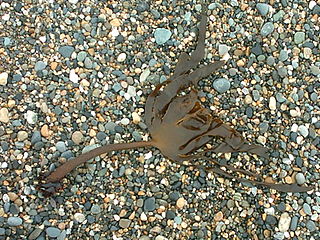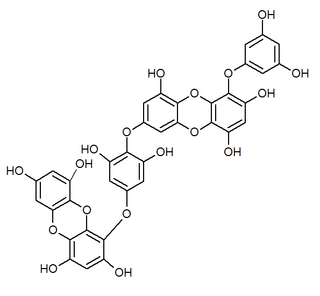
Lipopolysaccharides (LPS), also known as endotoxins, are large molecules consisting of a lipid and a polysaccharide composed of O-antigen, outer core and inner core joined by a covalent bond; they are found in the outer membrane of Gram-negative bacteria.

Saussurea is a genus of about 300 species of flowering plants in the thistle tribe within the daisy family, native to cool temperate and arctic regions of East Asia, Europe, and North America, with the highest diversity in alpine habitats in the Himalayas and East Asia. Common names include saw-wort and snow lotus, the latter used for a number of high altitude species in East Asia.
Seoul Institute of the Arts is a prominent educational institution specializing in the Arts. The school has nurtured many graduates who are actively working in art related fields within Korea as well as internationally. The Namsan campus in the heart of Seoul is used for presentation of arts productions and convergence with industry. The Ansan Campus opened in 2001 and is used for educational training, which aims to tear down barriers between disciplines, genres, and majors. The Institute continues to be a forerunner in globalization of Korean arts and creation of new forms of arts.
Zymomonas mobilis is a Gram negative, facultative anaerobic, non-sporulating, polarly-flagellated, rod-shaped bacterium. It is the only species found in the genus Zymomonas. It has notable bioethanol-producing capabilities, which surpass yeast in some aspects. It was originally isolated from alcoholic beverages like the African palm wine, the Mexican pulque, and also as a contaminant of cider and beer in European countries.

Zusanli is an acupoint, a point of the skin that is stimulated, with various techniques, in the practice of acupuncture. It is located below the knee, on the tibialis anterior muscle, along the stomach meridian.

CD99 antigen, also known as MIC2 or single-chain type-1 glycoprotein, is a heavily O-glycosylated transmembrane protein that is encoded by the CD99 gene in humans. The protein has a mass of 32 kD. Unusually for a gene present on the X chromosome, the CD99 gene does not undergo X inactivation, and it was the first such pseudoautosomal gene to be discovered in humans.

Sigesbeckia is a genus of annual plants in the aster family. St. Paul's wort is a common name for some of the species. Sigesbeckia is widely distributed and has been traditionally used for the management of chronic diseases, including arthritis. Based on phytochemical studies, the main chemicals in Sigesbeckia include flavonoids, sesquiterpenoids, diterpenoids, triterpenoids, and sterols. Kaurane-type and pimarane-type diterpenoids, including siegeskaurolic acid, kirenol, and sesquiterpene lactone are the main bio-active molecules in Sigesbeckia.

Ecklonia cava is an edible marine brown alga species found in the ocean off Japan and Korea. It is used as an herbal remedy in the form of an extract called Seanol, a polyphenolic extract, and Ventol, a phlorotannin-rich natural agent. Phlorotannins, such as fucodiphlorethol G, 7-phloro eckol, 6,6'-bieckol, eckol, 8,8'-bieckol, 8,4"'-dieckol and phlorofucofuroeckol A can be isolated from Ecklonia cava. Other components are common sterol derivatives.

Irigenin is an O-methylated isoflavone, a type of flavonoid. It can be isolated from the rhizomes of the leopard lily, and Iris kemaonensis.

Eckol is a phlorotannin isolated from brown algae in the family Lessoniaceae such as species in the genus Ecklonia such as E. cava or E. kurome or in the genus Eisenia such as Eisenia bicyclis.
![Gintonin Protein found in [[ginseng]]](https://upload.wikimedia.org/wikipedia/commons/thumb/c/c0/Gintonin_structure.jpg/320px-Gintonin_structure.jpg)
Gintonin is a glycolipoprotein fraction isolated from ginseng. The non-saponin ingredient was designated as gintonin, where gin was derived from ginseng, ton from the tonic effects of ginseng, and in from protein. The main component of gintonin is a complex of lysophosphatidic acids (LPA) and ginseng proteins such as Ginseng major latex-like protein151 (GLP151) and ginseng ribonuclease-like storage protein.

Dieckol is a phlorotannin that can be found in arame, in Ecklonia cava or in Ecklonia stolonifera.
Cynaropicrin is a sesquiterpene lactone of the guaianolide type found mainly in leaves of artichoke plants. It is one of the compounds that gives the artichoke its characteristic bitterness. It is found in artichoke leaves with an abundance of approximately 87 g/kg, but can hardly be found in other parts of the plant. Cynaropicrin makes up about 0.7% of leaf extracts of the artichoke. It exhibits a large diversity of bioactivities and shows properties such as anti-inflammatory, antifeedant and activation of bitter sensory receptors, but has not yet been used in medicine. Despite its pharmacologically beneficial properties, it can be toxic in higher doses. The compound has attracted attention in recent years as a potential anticancer drug.

3,4,8-Trimethoxyphenanthrene-2,5-diol is one of the 17 phenanthrenes found in the extract of the stems of the orchid Dendrobium nobile.
YG KPlus is a model management company established by fashion model-turned-CEO Go Eun-kyung. It is currently owned by YG Plus, a subsidiary of South Korean entertainment company YG Entertainment.

The Good Wife is a South Korean television series starring Jeon Do-yeon, Yoo Ji-tae and Yoon Kye-sang. It is a Korean drama remake of the American television series of the same title which aired on CBS from 2009 to 2016. It replaced Dear My Friends and aired on the cable network tvN every Fridays and Saturdays at 20:30 (KST) for 16 episodes from July 8 to August 27, 2016.

Misty is a 2018 South Korean television series starring Kim Nam-joo and Ji Jin-hee. The series marks Kim Nam-joo's small screen comeback after six years. It aired on JTBC's Fridays and Saturdays at 23:00 (KST) time slot from February 2 to March 24, 2018.

Record of Youth is a South Korean television series starring Park Bo-gum, Park So-dam, Byeon Woo-seok and Kwon Soo-hyun. The editing technique of foreshadowing has been used in many episodes of this series. It aired on tvN from September 7 to October 27, 2020, every Monday and Tuesday at 21:00 (KST), and is available for streaming worldwide on Netflix.










![Gintonin Protein found in [[ginseng]]](https://upload.wikimedia.org/wikipedia/commons/thumb/c/c0/Gintonin_structure.jpg/320px-Gintonin_structure.jpg)




